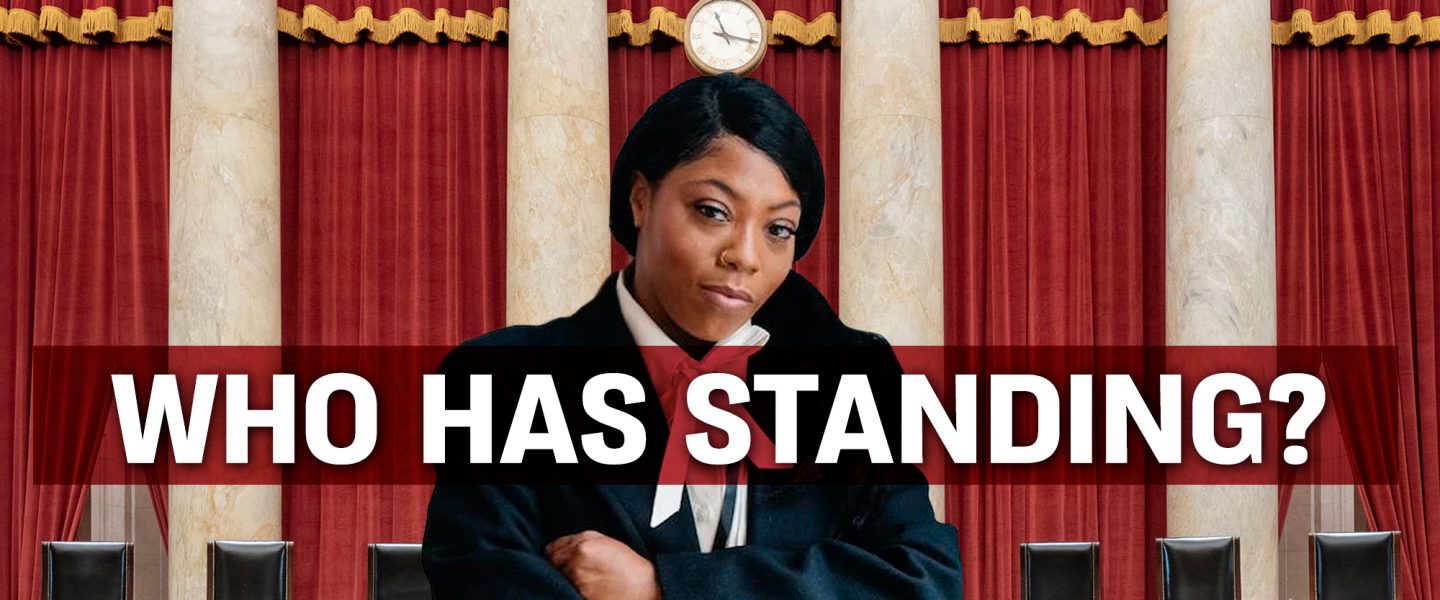It is a sad commentary on the state of SCOTUS jurisprudence and political capture that anything not completely regressive or disastrous from this court now feels like a surprise gift brought by Santa at Christmas time.
|
Listen To This Story
|
As it wrapped up a term that predictably pushed America still further to the right, the US Supreme Court gave a quick nod to its conservative stance on standing, a legal term regarding who has the ability to sue or intervene in a given case — and a procedural hurdle that has proven of great utility to courts in batting away cases they’d rather not hear or decide on the merits.
In the student debt forgiveness litigation, there were two sets of plaintiffs challenging the law. In Department of Education v. Brown the challengers were saying they were harmed because one person received no forgiveness and another was eligible for only half the forgiveness offered. But striking down the whole debt forgiveness plan wouldn’t have benefited either litigant, so their claim to standing before the court was questionable and the court in fact found they lacked standing.
In the second case challenging debt relief, Biden v. Nebraska, six states, led by Nebraska, challenged the plan because of loss of tax revenue. The standing issue jumps out in this case: If a state can challenge a law for how it affects the state’s tax revenue, it will open almost every federal law to challenge by the states. The standing doctrine exists, in large part, to keep the court doors closed to such a torrent of litigation by a host of plaintiffs at significant remove from the direct impact of a law, regulation, or other action.
Of course, as we will see, the converse is true on occasion: When a court wants to take and decide on a case — in the case of an activist court, often with the goal of making law and advancing a political agenda — it might have to twist itself in knots to find standing where the claim for it is highly dubious.
For better or for worse, courts are generally capable of such gymnastics — and the current SCOTUS is Olympic caliber.
No Standing? No Problem! C’mon In!
Missouri was one of the states that joined Nebraska in its suit but was also able to allege harm to a state-formed corporation, MOHELA, which the high court found relevant in finding standing. That was interesting because MOHELA itself had no interest in being involved in the lawsuit.
Missouri was alleging harm to a student loan corporation, and traditionally the courts have not allowed one entity to sue on behalf of another. In fact the suit was thrown out at the district court level for lack of standing. But an appellate court reversed the lower court and issued an injunction to stop the loan forgiveness from going forward until the case was fully litigated. With his program stymied by the injunction, President Joe Biden asked the Supreme Court to fast-track a decision.
Conservative jurists have long invoked standing as one of their core principles for limiting judicial “activism,” which is how they characterize liberal theories of legal interpretation. Fortunately for the court, there were two cases this term contesting the Biden student debt relief plan. This allowed the court to dismiss one case, Brown, in the debt-forgiveness controversy for not having standing.
But this commitment to the principle of standing lasted about a SCOTUS minute — which begs the question whether the first dismissal, of the Brown case, was to provide cover so the court could grant standing to a set of plaintiffs in Biden v. Nebraska with only a slightly larger fig leaf to cover the purely ideological purposes of their intervention. Because a strong argument could be made that neither case should have cleared the standing hurdle, evenly applied.
Celebrate! Only Half the Train Was Wrecked
The Nebraska decision, in which the court went on to strike down Biden’s forgiveness program, was one of a number of impactful decisions as the court came down the home stretch. A couple were surprising in a good way — though it is a sad commentary on the state of its jurisprudence and political capture that anything that isn’t completely regressive or disastrous from this court now feels like an unexpected gift brought by Santa at Christmas time.
The court, by an encouraging but tenuous 5-4 majority, declined to completely gut the Voting Rights Act and found that the lower court still had to apply the previously SCOTUS-battered act to test for racial gerrymandering. The court also declined an open invitation to destroy democracy by refusing to accept — by a 6-3 Moore v. Harper majority that included Chief Justice John Roberts and Justice Brett Kavanaugh — the “independent state legislature” theory, which called for completely cutting out the state executive and judicial branches from a role in the conducting of federal elections.
With the court taking cases and finding standing based on made up claims, have we entered a new era in which any law can be challenged by anyone, since the court won’t look closely or seriously at such traditional and inveterate requirements when it has policy to make?
However, there were a number of distressing decisions removing fundamental protections and privileges that have been broadly relied upon for decades. Just as Roe v. Wade met its end about a year ago, affirmative action crumbled this session. And signs saying service is refused to those in classes supposedly enjoying constitutional protection may once again become the norm thanks to 303 Creative v. Elenis.
That case, aside from the result — ostensibly prioritizing the free-speech rights of a website designer who refused to design a site for a gay couple — is already notorious for its apparent lack of factual basis. The business-owner plaintiff seemingly made up the request from the gay couple, as the man it came from not only denies making the request, but was married to a woman at the time he supposedly requested a website for his gay marriage.
Is It Now Open Season on Laws the Right Doesn’t Like?
With the court taking cases and finding standing based on made-up claims, have we entered a new era in which any law can be challenged by anyone, since the court won’t look closely or seriously at such traditional and inveterate requirements when it has policy to make?
Debt relief is not the long-standing social bulwark the court blew down when it took on affirmative action or reproductive rights. But it was an important policy commitment for Biden and the Democratic Party, the fulfillment of a campaign promise that likely contributed to his election. The court’s right-wing supermajority made quick work of striking it down.
The majority decision drew some sharp criticism from Justice Elena Kagan, the author of the dissent from the court’s liberal wing:
So, again, Congress delegates broadly. Except that this Court now won’t let it reap the benefits of that choice. And that is a major problem not just for governance, but for democracy too.
Kagan comes right out and labels the principle behind this decision as one that is not merely wrong but a threat to our democracy itself. And she does not flinch from calling out the court’s evisceration of the very standing doctrine that the conservative justices had long championed, as recently as Justice Clarence Thomas in the Moore case mentioned above:
[I]n a case not a case, the majority overrides the combined judgment of the Legislative and Executive branches, with the consequences of eliminating loan forgiveness for 43 million Americans.
Kagan makes abundantly clear her view of the majority giving standing to plaintiffs that were not harmed by the law in question, calling it “a case not a case.” Combining this with the manufactured controversy in 303 Creative, it’s fair to ask whether any law or regulation is safe from this adventuresome court.
As if blowing through long-established procedural red lights like standing were not enough, the court also found last year a novel road to its gutting of the Clean Air Act, when it invoked the “major question” doctrine in West Virginia v. EPA where it found the EPA couldn’t cap greenhouse gasses in a way that would force transformation away from Republicans’ beloved fossil fuels. Apart from its immediate bleak policy impact, the major question doctrine takes its place as a new SCOTUS WMD aimed squarely at the executive branch’s ability to regulate — an arms buildup that will surely put smiles on the faces of the billionaire patrons who have paid for private planes for Justices Thomas and Samuel Alito.
A SCOTUS Built to Perpetuate Minority Rule
The conservative capture of the court can be traced to then-Senate Majority Leader Mitch McConnell’s (R-KY) high-stakes gambit during the Obama presidency. When Merrick Garland, a middle-of-the-road, noncontroversial judge was nominated for a Supreme Court seat, McConnell took the unprecedented step of refusing to have hearings on the nomination as required by the Constitution’s “advice and consent” clause. He has referred to it as one of his “proudest moments in the Senate.”
McConnell’s move led to an energized conservative base turning out for Donald Trump, knowing that a make-or-break seat on the court now hinged on the 2016 election. This began the evangelicals’ devil’s bargain with Trump, turning a blind eye to his sinning behavior in his private life in exchange for the judges they needed to overturn Roe v. Wade (for starters).
And this wound up being one of the very few times Trump has turned out to be trustworthy. He gave them a trio of young firebrand justices with ideological axes to grind. Culminating that tour de force — in an election year that saw McConnell, with spectacular and shameless “flexibility,” reverse his “thoughts” on the viability of election-year nominations — Trump gave the evangelicals Justice Amy Coney Barrett, a jurist who participated in a radically fundamentalist sect of Christianity, “People of Praise,” where she was known, literally, as a handmaid.
The Right’s capture of the Supreme Court is of a piece with their ability to wield political process like a club, taking outsize power out of all proportion to their numbers of voters across the country. Examples of manipulation of structure and process to gain and hold power abound.
The Right’s capture of the Supreme Court is of a piece with their ability to wield political process like a club, taking outsize power out of all proportion to their numbers of voters across the country. Examples of manipulation of structure and process to gain and hold power abound.
If a Democrat wins a gubernatorial election in a state with a conservative legislature, we should not be surprised when that legislature strips the governor of powers weeks before he takes office. It’s happened in multiple states.
Donald Trump lost the election to Hillary Clinton by millions of actual votes but nonetheless prevailed, an increasingly frequent outcome owing to the rural-state bias of the Electoral College.
GOP senators represent fewer people in the Senate by millions (fun fact: half the US population is now represented by 83 senators — disproportionately of course from red states). And they have consistently wielded the filibuster to block majority-approved measures.
Gerrymandered state legislatures give the GOP two-thirds representation in states, such as North Carolina, where the overall vote is split nearly 50-50.
In short, the GOP has turned the art of dominating a democracy by representing fewer people into an artform.
It is some small solace that this SCOTUS did not have the votes to place our democracy entirely in the hands of these gerrymandered legislatures, and they preserved some skeletal remains of the Voting Rights Act. Our democracy is still intact for now. But it is hard to recall any SCOTUS that has so fundamentally changed our political landscape in such a hurry.
Doug Ecks is a lawyer and writer. He holds a JD from the University of California, Hastings and a BA in philosophy from California State University, Long Beach, Phi Beta Kappa. He also writes and performs comedy as Doug X.





